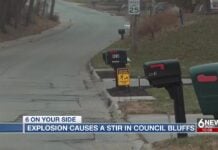A research team of international space scientists, led by Dr. Matthias van Ginneken from the University of Kent’s School of Physical Sciences, has found new evidence of a low-altitude meteoritic touchdown event reaching the Antarctic ice sheet 430,000 years ago.

Extra-terrestrial particles (condensation spherules) recovered on the summit of Walnumfjellet (WN) within the Sør Rondane Mountains, Queen Maud Land, East Antarctica, indicate an unusual touchdown event where a jet of melted and vaporized meteoritic material resulting from the atmospheric entry of an asteroid at least 100 m in size reached the surface at high velocity.
This type of explosion caused by a single-asteroid impact is described as intermediate, as it is larger than an airburst, but smaller than an impact cratering event.

The chondritic bulk major, trace element chemistry and high nickel content of the debris demonstrate the extra-terrestrial nature of the recovered particles. Their unique oxygen isotopic signatures indicate that their interacted with oxygen derived from the Antarctic ice sheet during their formation in the impact plume.
The findings indicate an impact much more hazardous that the Tunguska and Chelyabinsk events over Russia in 1908 and 2013, respectively.
This research, published by Science Advances, guides an important discovery for the geological record where evidence of such events is scarce. This is primarily due to the difficult in identifying and characterizing impact particles.
The study highlights the importance of reassessing the threat of medium-sized asteroids, as it likely that similar touchdown events will produce similar particles. Such an event would be entirely destructive over a large area, corresponding to the area of interaction between the hot jet and the ground.
Dr. van Ginneken said: “To complete Earth’s asteroid impact record, we recommend that future studies should focus on the identification of similar events on different targets, such as rocky or shallow oceanic basements, as the Antarctic ice sheet only covers 9% of Earth’s land surface.
“Our research may also prove useful for the identification of these events in deep sea sediment cores and, if plume expansion reaches landmasses, the sedimentary record.
“While touchdown events may not threaten human activity if occurring over Antarctica, if it was to take place above a densely populated area, it would result in millions of casualties and severe damages over distances of up to hundreds of kilometers.”
Here the abstract of the Science paper:
“Large airbursts, the most frequent hazardous impact events, are estimated to occur orders of magnitude more frequently than crater-forming impacts. However, finding traces of these events is impeded by the difficulty of identifying them in the recent geological record. Here, we describe condensation spherules found on top of Walnumfjellet in the Sør Rondane Mountains, Antarctica. Affinities with similar spherules found in EPICA Dome C and Dome Fuji ice cores suggest that these particles were produced during a single-asteroid impact ca. 430 thousand years (ka) ago. The lack of a confirmed crater on the Antarctic ice sheet and geochemical and 18O-poor oxygen isotope signatures allow us to hypothesize that the impact particles result from a touchdown event, in which a projectile vapor jet interacts with the Antarctic ice sheet. Numerical models support a touchdown scenario. This study has implications for the identification and inventory of large cosmic events on Earth.” [Science, Phys.]
Now subscribe to this blog to get more amazing news curated just for you right in your inbox on a daily basis (here an example of our new newsletter).
You can also follow us on Facebook and/ or Twitter. And, by the way you can also make a donation through Paypal. Thank you!
You should really subscribe to QFiles. You will get very interesting information about strange events around the world.













Hmmm, he did say if an airburst happened over a densely populated area…
I wonder who God Almighty will aim his wrath at next? Quite a bit of falling away (apostasy) these days. Quite a bit of strong delusion too. We need a mass repentance. We really do.